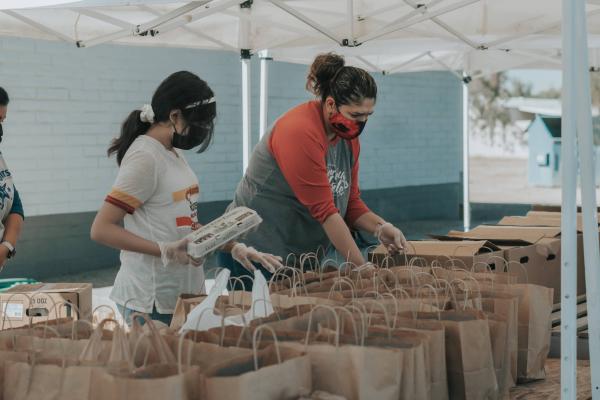Libraries of all types are taking on new roles and responsibilities. Through robust programming agendas, they’re at the center of community-building efforts all across the United States.

As part of the National Impact of Library Public Programs Assessment (NILPPA), Knology sat down with advisors from across the library sector to discuss the impacts libraries aim to have on the communities they serve. During these discussions, we also brainstormed ways to track these impacts across various domains of community life. Two important ideas emerged from our conversations:
- Impact Domains
Specific areas where library programs can make meaningful differences in people’s lives. We defined nine of these. Libraries can help create: (1) connected communities; (2) knowledgeable communities; (3) creative communities; (4) civically engaged communities; (5) healthy communities; (6) economically vital communities; (7) welcoming communities; (8) joyful communities; (9) caring communities.
- Indicators
Ways of measuring the real-world impact of library programming. These Indicators allow us to determine whether or not programs are having their intended effects.
In this series of blog posts, we’d like to talk about each of these impact domains individually, and talk about how libraries are contributing to each of them. In this final post, we focus on caring communities.
What are Caring Communities?
A caring community is one that provides support to those in need, and whose members treat one another with compassion and empathy. Caring communities promote prosocial values and behaviors, and help people make commitments to each other in ways that lead to interpersonal awareness and mutual helping. They also foster a sense of social responsibility, especially for the most vulnerable community members. Libraries can help build caring communities by creating spaces that allow for cooperative learning and group collaboration, and by developing programs that foster kindness, justice, tolerance, considerateness, and concern for others.
Example: Helping Senior Citizens at the Tryon Public Library
At the Tryon Public Library in Tryon, Oklahoma, staff realized they were having difficulties reaching senior citizens — many of whom were struggling with food insecurity and hunger, among other vulnerabilities. After exploring available resources to address this important local concern, the library succeeded in helping seniors meet their nutritional needs. Describing the program, one library worker noted how “more seniors are now coming to the library once a month to pick up sacks of food,” and how in other cases, “we are delivering food to them.” The library’s efforts also stimulated discussions about other kinds of programs and services (including a senior center) needed to help seniors become more active members of the community.
Example: Learning from Asylum Seekers at the Waterbury Public Library
The Waterbury Public Library in Waterbury, Vermont, collaborated with the Central Vermont Refugee Network for a panel discussion called Bridging Continents: The Life and Experiences of Refugees and Asylum Seekers in Central Vermont. Two asylum seekers from Central Vermont shared their stories and struggles, and roughly three dozen local participants attended. After the event, an article in the Waterbury Roundabout spoke to the vulnerabilities asylum seekers experience “on a daily basis,” including racism, lack of public transportation, and being “taken advantage of” on account of a lack of English fluency.
How Can You Help Build a Caring Community?
As these examples show, there are lots of different ways libraries can help care for the community’s most vulnerable members. Your library likely already has programs targeted to your specific community's greatest needs, such as:
- Programming and resources for homebound residents who can't come to the library
- Opportunities for patrons to volunteer in the community, or to donate food, clothing, etc. to those who need it most
- Support for unhoused community members
- Programs that raise awareness about societal inequities and what residents can do to reduce them, such as ALA's Great Stories Club
Let’s Put it To Work!
We’re interested in learning more about how you think libraries can create caring communities. How do programs at your library support caring behaviors within your community? What partnerships do you have that help you meet this goal? And how else might libraries help the communities they serve become more caring?
Let us know what you think about these things. You can either comment below or email programminglibrarian@ala.org. And for more information on this topic, please consult the literature cited below.
Additional Resources
Foust, M. (2014). Kindness counts: encouraging empathy in secondary school library programs. In IASL Annual Conference Proceedings.
Hendry, J. D. (1988). Caring libraries in a caring society. Library Review, 37(3), 38-45.
These materials were produced for National Impact of Library Public Programs Assessment (NILPPA), a project funded by the Institute of Museum and Library Services. The authors are solely responsible for the content on this page.
Written by Knology. This blog has been co-posted on Programming Librarian, NILPPA and the Knology website.
Knology is a nonprofit research organization that produces practical social science for a better world. The organization pursues this goal to help professionals in a variety of sectors build inclusive, informed, and cooperative societies that can thrive together with the natural systems on which we all depend. As a transdisciplinary collective of over 30 social scientists, writers and educators, the organization's work process is built on equity, transparency and deliberation.



